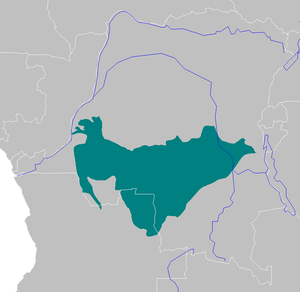Southern Congolian forest-savanna mosaic
The southern Congolian forest-savanna mosaic is an ecoregion that covers a large area of the southern Democratic Republic of the Congo and northeastern Angola. Its rich blend of habitats provides key insights into the biogeography of central Africa with the extensive climatic variation that it has been experiencing for the last 10 million years. The human population is not high.[2]
| Southern Congolian forest-savanna mosaic | |
|---|---|
 map of the Southern Congolian forest-savanna mosaic | |
| Ecology | |
| Realm | Afrotropical |
| Biome | tropical and subtropical grasslands, savannas, and shrublands |
| Borders | |
| Geography | |
| Area | 565,812 km2 (218,461 sq mi) |
| Countries | Democratic Republic of Congo and Angola |
| Conservation | |
| Conservation status | Vulnerable |
| Protected | 19,841 km² (4%)[1] |
Geography
The Southern Congolian forest-savanna mosaic is a transitional region between the equatorial Congolian forests region to the north and the woodlands and savannas of the Zambezian region to the south. The Central Congolian lowland forests lie to the north, west of the Congo River, and the Northeastern Congolian lowland forests are east of the Congo. In the highlands to the east are the Albertine Rift montane forests. The Central Zambezian miombo woodlands lie to the southeast, and the Angolan miombo woodlands to the southwest. To the west is the Western Congolian forest-savanna mosaic.[3]
Central Africa is familiar with repeated climatic variation that have caused rain forest and savanna expansion and deflation in consideration of the late Pleistocene tectonics defined the Congo Basin.[4] Important climatic shifts have occurred more than 20 times in less than 10 million years.[5] Plants and animals adapt, change, and go extinct with any climatic oscillation. Widespread and immensely resilient organisms that lived through in islands of habitat and accustomed to spatial fluidity were favored.[5] During dry periods, savanna communities breached far into the Congo Basin. The relatively moist riparian forests become detached from one another and compose forest island localities in the savanna matrix.[5][6][7][8]
Fauna
The ecoregion is home to African bush elephants (Loxodonta africana).
Conservation and threats
The political situation in the Democratic Republic of the Congo is unstable; until the country is stable, no important conservation work is likely.[2]
Protected areas
A 2017 assessment found that 19,841 km², or 4% of the ecoregion is in protected areas.[9] Protected areas include Mangai Nature Reserve (1903.33 km²), and Bushimaie Hunting Reserve (4368.7 km²).
External links
- "Southern Congolian forest-savanna mosaic (World Wildlife Fund)". Terrestrial Ecoregions. World Wildlife Fund.
References
- Eric Dinerstein, David Olson, et al. (2017). An Ecoregion-Based Approach to Protecting Half the Terrestrial Realm, BioScience, Volume 67, Issue 6, June 2017, Pages 534–545; Supplemental material 2 table S1b.
- Kelman, Illisa. "Central Africa: Democratic Republic of the Congo and Angola". World Wildlife Fund. Retrieved 2013-12-23.
- Burgess, Neil, Jennifer D'Amico Hales, Emma Underwood, et al. (2004). "Terrestrial Ecoregions of Africa and Madagascar: A Conservation Assessment". World Wildlife Fund. Island Press, 2004, pp. 294-296.
- Faniran, A.; L.K. Jeje (July 1984). Humid Tropical Geomorphology: A Study of the Geomorphological Processes and Landforms in Warm Humid Climates. Longman Group United Kingdom. ISBN 978-0582643468.
- Kingdon, Jonathan (May 1990). Island Africa: The Evolution of Africa's Rare Animals and Plants. Princeton, NJ: Princeton University Press. ISBN 978-0691085609.
- White, Frank (1983). The vegetation of Africa: a descriptive memoir to accompany the Unesco/AETFAT/UNSO vegetation map of Africa. UNESCO. ISBN 9789231019555.
- Smith, Thomas B.; Robert K. Wayne; Derek J. Girman; Michael W. Bruford (20 June 1997). "A Role for Ecotones in Generating Rainforest Biodiversity". Science. 276 (5320): 1855–1857. doi:10.1126/science.276.5320.1855.
- "Savannas of the Green Heart of Africa". World Wildlife Fund. Retrieved 1 March 2014.
- Eric Dinerstein, David Olson, et al. (2017). An Ecoregion-Based Approach to Protecting Half the Terrestrial Realm, BioScience, Volume 67, Issue 6, June 2017, Pages 534–545; Supplemental material 2 table S1b.